eDiscovery Project Management: “Big Picture” Planning

Yesterday, we introduced the series focused on Applying Project Management Techniques to Electronic Discovery and the areas we will cover over the next few weeks. Today, we will begin the discussion with planning the project.
It is unlikely that any project will be successful without good planning – both “big picture” planning and the planning of specific tasks. First you need to look at the 10,000 foot view and identify all the pieces and how they fit together. Then you need to look at the specific pieces and prepare a plan for accomplishing each.
“Big Picture” Planning
Let’s walk through a common scenario to illustrate preparing a big picture plan. Let’s say you are responsible for managing the electronic discovery tasks on a case, starting with the collection of documents and carrying through to production.
As a first step, identify the tasks that are required. Your task list might look like this:
- Determine where responsive materials may reside and prepare a data collection plan.
- Make forensically sound copies of potentially responsive materials.
- Identify a service provider to process data and load into a first pass review tool.
- Use the first pass review tool to cull the collection (this should be done by litigation team members who are familiar with the case and the documents, and who are responsible for case strategy and making decisions. They should work together with search technology experts).
- Identify the review tool to use for identifying responsive documents.
- Assemble and train the review team
- Manage the document review team
- Generate the production set.
Of course, the tasks on your list will depend on the scope of your project and the size of your collection. You many not need to include all of the tasks on this list, or you may need to include more.
For each task on your list, determine by when it needs to be done, who will be responsible, and a general approach (for example, you may determine that you’ll need a contract team for reviewing documents).
There you go. You’ve got your big picture plan for moving forward. Tomorrow, we’ll talk about planning specific tasks.
So, what do you think? Need any help with “big picture” planning to get your project off to a good start? Please share any comments you might have or tell us if you’d like to know more about a particular topic.


